Albert Potrony
In Conversation with Jean Tormey
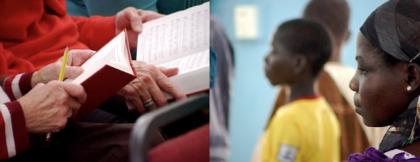
[Faith Video Still, Albert Potrony]
Albert Potrony works with installation, sound and video. Participation is a key element in his projects. His recent project Faith, a multi-channel video installation with material spanning across Nigeria and the UK, was shown early this year at Whitstable Museum and Gallery. Last year he developed Tate Other, a collaborative video and performance that took place at Tate Modern in September 2012 as part of the Worlds Together Conference. He is now developing Another Utopia, a collaborative project exploring the squatting and housing co-operative movements of the late 70s and 80s in London. Albert has been working on participatory projects for galleries and museums for the past ten years, among them Gasworks, Tate, Whitechapel, Camden Arts Centre and Next Generation at the National Theatre.
For the recent opening of new learning spaces at Tate Britain, Albert devised Meet Art, a pick-up activity for families to use in the galleries and In Material, an iteration of the Early Years and Families Open Studio programme. Meet Art is a playful subversion of Tate Britain’s pocket guidebook around themes of architecture, space and design; which connects to In Material - an installation of larger than life materials for people to explore, make connections and build with. Albert worked on the concept of Time Loop, the recent BP Family Festival at Tate Britain, and also works on the Big and Small programme of events, projects and resources - particularly on outreach projects aimed at Looked after Children and their carers.
In the interview, Albert talks about his work, why he became an artist, what he is inspired by and how he views the different elements of his work with people.
Can you tell me a bit about your practice as an artist?
I’ve been working with people for a few years now. I trained as a sculptor and did a lot of installation work for many years, starting to do education work as a means of earning a living and support my practice. I was at a point where a few things were emerging, but the fact of being in the studio constantly without sharing the process was dissatisfactory. At the same time, I was becoming very comfortable and excited about sharing that practice as part of education workshops. There came a moment where the two things started to influence each other and began to merge quite a bit. Initially it was quite separate, but over the last 10 years all of my work has started from encounters with people - things that I am interested in that arise from meetings with groups or individuals - which take me on a journey, on a process of trying to find out things - the unexpected ‘accidents’ within the journey, leading the project in one direction or another. I tend to use different strategies from sound to video, sculpture and mainly installation work.
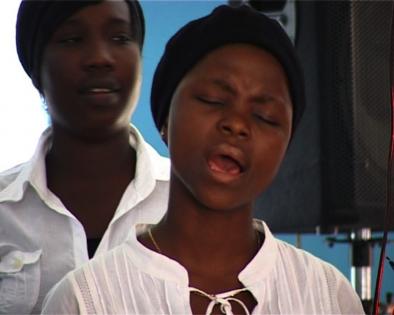
[Albert Potrony, Faith, 2010]
How would you describe your studio?
At the moment it’s quite a small studio. There is a lot of editing happening, and also a bit of making - something I want to claim back a bit more in fact. I’ve been spending a long time recently working on the computer - editing film from interactions, gathering material together from meeting people. I’ve also been working with collage and drawing, and I’m interested in how to bring all of these different elements together. The studio for me is a place for thinking, for isolating myself - the funny thing now is that the problem I had previously felt with my studio is now the asset, and the studio has become a space that I sometimes crave when in the world working with groups - a space for quiet, to digest the work I’ve done with groups and the things that have happened, to reflect and push work forward.
At Tate Britain you’ve been involved in many different strands of recent programming - from outreach projects as part of Big and Small to the BP Family Festival and the programme devised for the new spaces at Tate Britain - in particular Open Studio. Did you think about your own studio when coming up with ideas for this?
Yes, there were a few things. In the studio you just put things together and it can be quite a random process to start with. Normally, when I start a project I have an idea or an interest but it’s not a defined thing - I never know where it’s going to go next - which can be nerve-wracking , but it comes from my early days of being an artist when I used to work with metal and all the creativity was involved in making models, so making the final pieces was just about the act of reproducing the model which I found frustrating. I’m very conscious of not closing things down at an early stage now. The studio is a place to put things together - sometimes randomly and see what happens - to see what works and what doesn’t work - part of which I’ve tried to replicate in Open Studio.
In my studio there may be objects and images lying around relating to projects I’m working on - some things will go up on the wall, other things will come down, and connections will be made between things - the studio becomes almost like an editing suite where you can see things evolving. When planning the objects for Open Studio, I was focused on the idea of materiality and how materials could be used to make something else. It’s about exploring materials you may never have encountered before but which have a connection to art making - creating a space where you may randomly start putting things together while exploring the quality of the materials you are working or playing with. It’s a very playful process, but then something might emerge from putting 2 things together (you might create a different shape, or a shelter) which then hopefully takes you to a more informed position. Starting with a playful moment you find something and then you develop it - which is basically an artist’s process. I’m hoping this is what the set up in Open Studio will enable and encourage - together with the visual attractiveness of the materials. Encouraging children and adults to explore materials and space this way should be very interesting.
[Albert Potrony, In Material, Open Studio Tate Britain, 2013]
Getting back to the studio - my workspace is also a place where things are exhibited - which is another element of the making that’s always in my head. If I know where a work is going, it becomes part of the process. I think that’s what I was hoping when approaching the idea of the Open Studio - having this space that has to be colonised or transformed by the actions of the families and children - and that the actions of one group has an impact on what another group does - that somehow this is creating a dialogue - so that what is there before you arrive has an impact on what you do, and the space will never be the same.
I think what you’ve been talking about is really how to create the conditions for open-ended, self-directed engagement where families are working together - which is exactly what we’re trying to do with Open Studio.
Yes, one of the things I’m really interested in throughout all my work is hierarchies - how we can turn these things we take for granted on their head. I am interested in creating a space where children and parents/carers can see each other in a different light - because they have to collaborate (in a space like Open Studio), and fixed roles can shift. At some point the child might be leading, but will need the help of an adult to realise the work due to the scale or type of materials that have been selected. The scale has to be small enough for children to manipulate, but large enough to encourage the collaboration that allows the work to grow and takes it somewhere else. An aim of all of my work with people is realising creative spaces where role-shifting, collaborating and seeing each other in a very different light can occur.
This was one of the major successes of the last two Big and Small Foster Family Projects you worked on with us - creating a space where members of families could see each other differently.
Yes, I’m very interested in this. When I’m running a session for families the sessions are for everybody - not about some participating and others observing, but about all of us finding a way of going through a process and seeing what we can make out of that - physically and in a way, socially.
[6 days to build a new world, Big and Small Foster Family Project with Albert Potrony, 2013]
You’re involved in many different strands of the programme at Tate Britain (outreach and drop-in, projects, spaces and resources) and to my mind have the same approach with all of them. Do you agree with this? Do you think as an artist you need to be aware of where different audiences are coming from?
I feel like my main contribution to the programme is through outreach and that the approach I’m taking stems back to the first project of this kind I did at Tate Britain - a project with Asylum Seekers with [previous Curator on the Early Years and Families programme] Katy Fitzpatrick. Although technically a different strand of programme, the principle is similar - working together and learning from each other somehow, arriving somewhere through a journey we embark on together. In that sense I feel there’s a similar vein that goes through much of this work that is to do with trying to change the focal point of knowledge and authorship - we are not all experts, but we can all have an input.
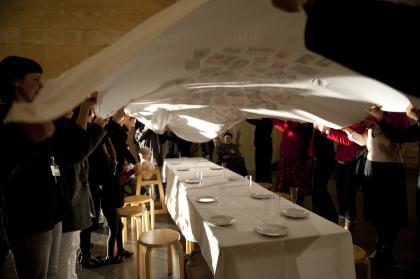
[Family Matters, Tate Britain, 2012]
Is this also to do with accessing the gallery as a resource - that everyone comes with their own personal knowledge that influences the thoughts they have about what they view?
Exactly - in the very early days of researching a very different type of programme - the Big and Small Map for Making resource (which led to the Meet Art resource that has been devised for independent, drop-in audiences), we did a few sessions working with families. In these sessions I was asking how we can create a moment of investment for families so that when they view works in the Gallery, they feel they have more of a connection with them. This connection allows a bit more relaxation to occur that says, ’I’m entitled to be here’, ’I know why I’m here’ and ’I have an inkling of how to engage with this situation due to previous experience’. It is one thing to do this in a session where you are there, you are modelling things. In reality a resource that can be used by everyone has to be very pared down, but still have the potential to do much more than simply guide people around the Gallery. So you have something that involves making, but it’s really about you making decisions and being OK with that, hopefully leading to a self-directed exploration of the galleries where you end up chucking away the resource to make up your own mind about the works you’re looking at.
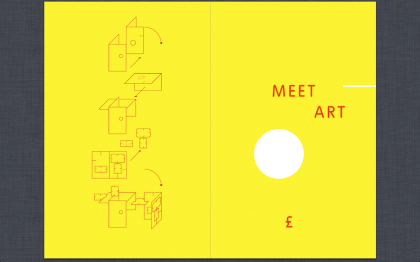
[Meet Art, Early Years and Families pick-up activity, 2013/ 14]
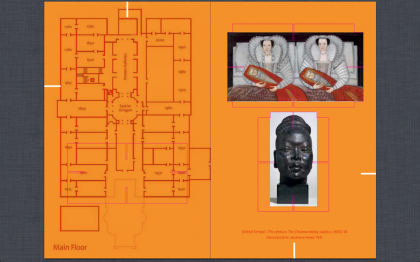
[Meet Art, Early Years and Families pick-up activity, 2013/ 14]
So the resource is something to focus on - while transforming the conventional guide book into something you can build and create an object with or look through..
Yes, and for me it relates to my practice, which is always about looking at what’s there in a different way, exploring what’s already there. This strategy was very important when devising the Map for Making (the original Big and Small resource I worked on) which is a play on the official Tate Britain Map and Guide and will be posted to hard-to-reach groups, to give people an experience before they come to the gallery so they can say - I have a relationship to this. It was important for me to use something that was already there and was recognisable.
This makes a lot of sense, as we find that many of the hard-to-reach families we are trying to attract to the gallery mightn’t know where it is, how to get here or that it’s free of charge every day, for instance. There’s a real appetite for visiting the gallery once you build awareness of what’s on offer.
There’s also an aesthetic and formal relationship with the resources I’ve devised for Tate Britain recently and Open Studio. This was a conscious decision - creating a linkage between the two that is about something becoming what it was not intended to be - something flat becomes 3D or something being used for a very different purpose. You can use the pieces in the resources as viewfinders or to make constructions. This is intended to challenge peoples’ preconceptions of what you do when you look at art in a Gallery - that you should know what it is and what it ‘means’. It’s about tackling those things from a different angle in terms of (what looks like) a conventional gallery guide that you can transform into anything you want, or 3D materials that you can play with and transform into anything you like - from a shelter, to an abstract sculpture to a city etc. We’ll see what we get!
Yes, it’s great that the two link up so well because while the resource can be picked up at the information desk and used in the galleries, Open Studio is a separate facilitated space. Both of them link directly to the Collection and encourage interaction with artwork. In what ways do you find the Gallery and the Collection an inspiration for your work?
I’m not sure if it’s because I’ve been working here so much now over the last 3 years (I used to work more at Tate Modern), but I feel very comfortable - the Gallery feels like a 2nd home to me and an extension of things that feed into my studio. For example, I’ve been into the John Akomfrah Spotlight Room (The Unfinished Conversation) about 4 or 5 times now, the new re-hang of the Collection is brilliant, and because of the way the Gallery is laid out, it feels like there is an opportunity to really look closely at the works. Previously, I wasn’t really interested in 17th and 18th century works, but through the projects we’ve been working on in the re-hang, I’m finding those eras much more interesting now.
And does your work in the Gallery influence your studio practice?
The work I do in the Gallery with people feeds back to my own work at different levels. For the past few years my work has been really been about interaction (which it wasn’t before) and that’s because of all of the work I’ve been doing with groups and with people in gallery settings. However, there are points of complete overlap as in the case of a new commission I’m working on, provisionally titled ‘I am an artist..’. I’m looking at how we describe the process of making things, of art-making, juxtaposing these descriptions with the language of elitist art reviews and essays. For this project I will be filming 5 groups of 10 year old children working in a similar process to Open Studio. I’ll be filming the making that happens and how the children talk about what they’re doing. For this commission I’m using the setting of a session to make a new piece of my own work, while recognising all the different levels of authorship that the participants and I engage in.
This makes me think of how you have described working with people in the past - that sometimes you’re collaborating, sometimes standing back and sometimes leading.
Yes, and the degrees of how things work if you do one thing or the other. We were having this discussion at Gasworks in the context of a commission I am working on at the moment related to a specific piece of work I have been developing with them within their Even Better Together programme, and we have been discussing authorship a lot. Katie Orr and I were struggling for a long time trying not to influence things but we found no way around it - the fact is that often as an artist working with people you’re in a space of leadership, not of power necessarily. It’s about creating the space for the leadership to be as neutral as possible, or as neutral as possible at certain times (at other times you need to provide a framework for things to happen). You are always negotiating degrees of leadership or collaboration or being the ’extra hand’ as facilitator - from assistant to collaborator to facilitator, to leader, with the many degrees of greys in between.
Do you talk to participants as part of your work - their position and how they see themselves?
This is a very interesting question. When I am working with people in one of my own projects there is always an understanding that at the end of the process I am the one who is responsible for transforming all the material produced into a piece of work. There will be conversations on what I have in mind and what they imagine can be produced. More often, I have discussions linked to how can I use the material in an ethical way that does not misrepresent the participant’s input rather than discussions related to authorship.
On the other hand, with the Gasworks Peer Group project (mentioned above), for example, and the younger members involved, there is no issue - they immediately involve themselves as active agents in the process - taking the cameras and documenting what’s happening or taking part in brainstorming sessions, suggesting things to do etc. With the adult members, in the beginning they would either lead by suggesting ideas and activities or (more often) take the more comfortable ‘this is for the children’ attitude. These positions have been shifting quite interestingly during the 2 years the project has been running. Adults have been taking more ownership and a more equal place in the collaborative process, but there are always moments of relapse and there’s always a bit of discussion about that.
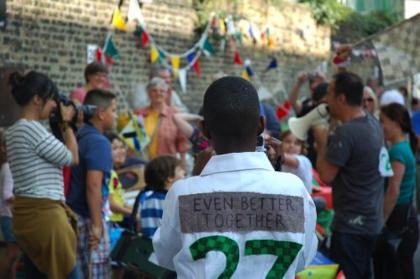
[Even Better Together, Gasworks Intergenerational Peer group]
Space for discussions to happen during a collaboration are very important as it’s about not knowing exactly where you’re going but knowing you want the same things, and trusting each other in that process.
Yes, this is possible with the Gasworks Peer Group as we’ve built that trust over a couple of years now - but it’s more difficult with the 6 week Big and Small Foster Family projects because, while we end up building a large amount of trust by the end of the project, I am very much in the position of leading the sessions. On the other hand, the Peer Group will tell me immediately when they don’t agree with something, when they want to drop things and move on. They’re happy for me to bring thoughts and ideas to the process - but are now very vocal about what they’re doing, what we are doing together. In a way we are always asking the question - who is in control? Or who is controlling too much? So although I have an idea of how things may go in a session, when you pose ideas to the group, things invariably go in a different way. This is exciting -you are never sure what’s going to come out of the process - it takes a longer time and can be nerve-wracking too but often things develop in a more interesting way than you imagined.
Yes, having faith in the process is important, and flexibility too - which reminds me of an artist’s way of working. When did you know you wanted to be an artist?
As children, in my family, we didn’t socialise as much as we wanted to, we had quite an isolated childhood. This had a positive side too, as I had to find ways of keeping myself entertained and from a very young age I was always making things. It took a long while to make the jump from making, as a means to create a world for myself, to thinking- ’oh I can be an artist’. When I was 19 I had to go to compulsory military service where my freedom was curtailed entirely for 2 years and on my return I decided I didn’t want to waste any more time and was going to go to art college. Although the process of making had started early on - finding ways to create different worlds to keep myself entertained as a child - it took me a while to realise I could make art for a living. I think coming to London to study and deciding to stay afterwards has had an important impact on how my work has evolved. Being an outsider allows you to look at things differently - you have to pay more attention and not take anything for granted - which has been invaluable for my practice.
Further information:
http://www.albertpotrony.co.uk/
http://www.tate.org.uk/whats-on/tate-britain/daily-activities/open-studio
http://www.tate.org.uk/visit/tate-britain/kids-and-families/big-small
http://www.tate.org.uk/whats-on/tate-britain/daily-activities/families-welcome-area
http://www.gasworks.org.uk/education/info.php

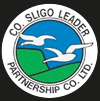
No comments added